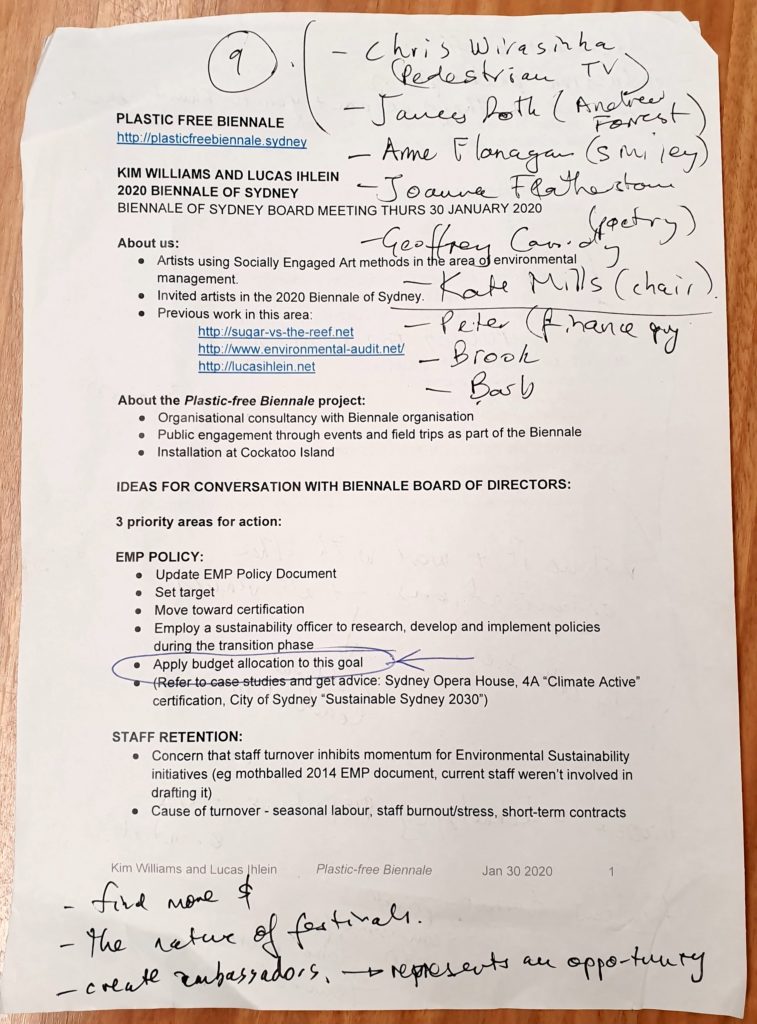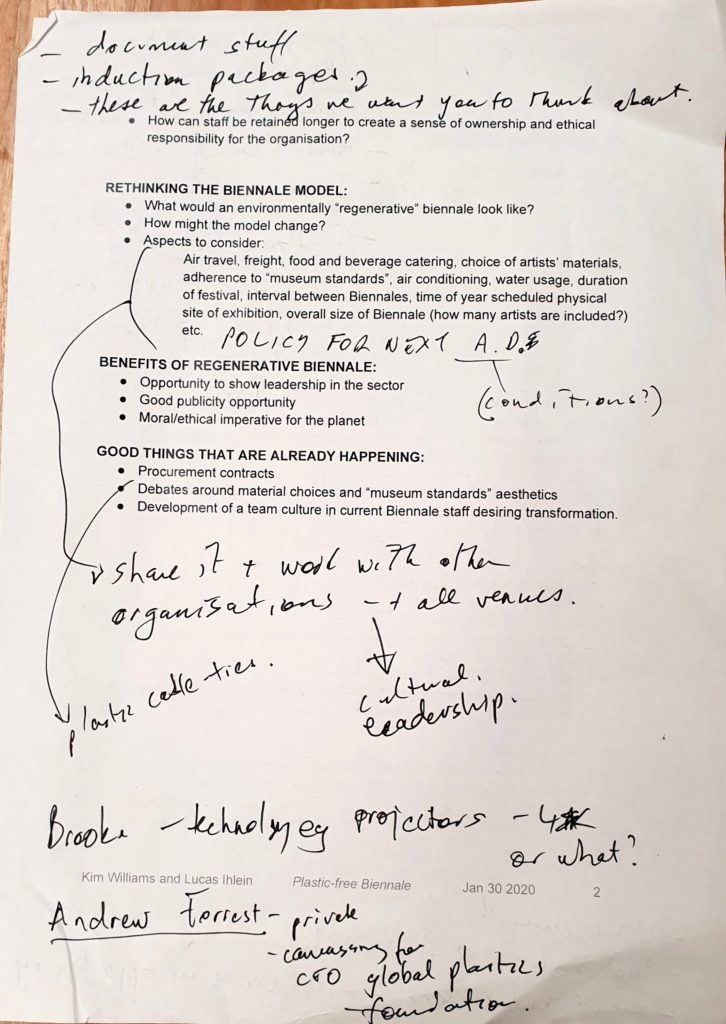
Sometimes when people ask “So, what kind of art do you do?”, I answer “Oh, mainly I make Google Docs”.
This is a joke of course, but it’s not entirely untrue. Alongside making things out of wood, printmaking, growing crops as artworks, and producing videos and songs, Kim and I do seem to create a plethora of Google Docs. Our projects have many moving parts, and we collaborate with heaps of people. Google Docs might not look very “arty”, but they can help guide a discussion, especially when you’re meeting with Important People with Limited Time.
Case in point – the time had come to meet the Biennale of Sydney’s Board of Directors. After hanging out with the staff semi-regularly for several months, we were ready to get some top-down support. So Belle, our main Biennale contact person, did her magic and booked us a spot at the January Board meeting.
We put together a simple Google Doc, which we handed out to the board. You can read the document here. Below is my scrappy annotated version.


We had three main points to bring to the table.
The first was this:
The Biennale already has an Environmental Management Plan (yay!) …. but … it was created in 2014 and hasn’t seen much light of day ever since (boo!).
Many of the staff, including Barb, the CEO of the Biennale, want to see a new EMP which is actually workable. Clearly something about the 2014 model didn’t fit with the way the Biennale functions, or else it wouldn’t have languished in a filing cabinet until 2020.
If you don’t know what an “EMP” is (and that will be many of us) here’s what it says on the Australian government’s website:
Environmental management plans describe how an action might impact on the natural environment in which it occurs and set out clear commitments from the person taking the action on how those impacts will be avoided, minimised and managed so that they are environmentally acceptable.
And of course, there’s a wikiHow on making an EMP…
All galleries and festivals have an environmental impact based on their core activities (carbon emissions from flights, shipping, materials used and waste generated, running an office etc). So if the Biennale wants to engage ethically with the local and global environment, then a plan of action and a policy are required!
So – a new EMP is needed. We recommended to the Board that actual resources should be put towards this. Time and labour will be required to do the research and development of this policy, which means that it will cost money. Someone on staff will have to be the Champion, and probably an external consultant will need to be engaged to help guide the process. (Note – we are not experts on any of this stuff, but these ideas just seem logical to us!)
The second thing we wanted to bring to the discussion was the issue of Staff Retention. This is something that the employees we’ve chatted with have mentioned several times, and we’ve observed it ourselves. The Biennale has a high staff turnover rate. The festival has a “boom and bust” model – every 24 months, the whole thing ramps up to fever pitch, everyone expends massive amounts of energy making it happen, and then they all collapse afterwards. Staff get burned out by this kind of intensity. And because of the biennale’s “seasonal labour” needs, many staff members are employed on short-term contracts. Both these factors (and there may be other factors!) mean that there isn’t much long-term continuity in staff.
We think (but we’d have to check for sure) that Barb the CEO is the only current staff member who was on the team back in 2014! With that much staff turnover, how can you expect employees to take a long-term sense of ownership about things like environmental policies that were created long before they began working for the Biennale?
The third issue we wanted to raise was the idea of the biennale model itself. We asked, “what would an environmentally regenerative biennale look like?” This is a question for all large scale festivals of this sort. Imagine if we stopped tinkering around at the edges to reduce our environmental impact, and instead started asking how our cultural activities could be actively beneficial to the environment. What might a biennale look like under those circumstances?
We didn’t get too far with this third point, mainly because we ran short on time. But this is something we are continuing to explore throughout the live period of our Plastic-free Biennale project (until June 2020).
While we were at the meeting, the Board members engaged in a broad and generous discussion. A few ideas stand out.
One was this: rebooting the EMP represents an opportunity for connection between cultural organisations. If there is a lot of staff mobility, as people move between the Biennale and other employers, then perhaps there is also the chance to create a broader coalition around environmental responsibility? These staff members who shift jobs could become ambassadors of a sort.
Another idea (a controversial one) was raised in the meeting. One of the board members proposed that since our project is about plastic, we could try to get philanthropic support from a new global plastics organisation that mining magnate Andrew “Twiggy” Forrest has started.
[I googled around and I think it’s this].
Is Twiggy to be trusted? What are the ethics of means-vs-ends in environmental transformation? This is something for Kim and I to think about!
At the end of the board meeting, we played our new song “Plastic in the House” which we recently recorded with a bunch of local Wollongong kids. It was a good way to change the mood in the room. Even though serious-looking Google Docs printed out on A4 pieces of paper can be very useful for discussing Important Matters, you can’t beat music as a catchy way to bring people together around a overwhelming problem like plastics.